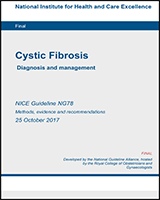Table 166Summary of included studies
| Study | Population | Prognostic indicator | Follow-up | Outcomes | Comments |
|---|---|---|---|---|---|
| Baker 2016 USA Retrospective observational study | N=63 adults with CF Mean age (SD): 31.7 (8.0) years (18 to 57) 50.9% male |
| 2 years (data available for n=39) |
| Subjects that did not have a repeat PA spine DXA were significantly younger and tended to have lower baseline PA spine z-scores. |
| Brenckmann 2003 Canada Retrospective observational study | N=40 adults with CF Mean age (SD): 28.7 (8.4) years (19 to 52) |
| 1 year (data available for n=27) |
| Subgroup analysis was not possible as sample size was too small. N=21 participants were receiving oral or IV corticosteroids |
| Bhudhikanok 1998 USA Prospective observational study | N=47 children, young people and adults with CF Mean age, range: 20.6 years (8.4 to 48.5 years) 30 female, 19 male
|
| Mean 17 months (11 to 25 months) (data available for n=41) |
| |
| Haworth 2002 UK | N=114 young people and adults with CF Mean (SD) age: 25.1 (6.9) |
| 12 to 13 months |
| |
| Prospective observational study | years (15 to 49)
|
|
| ||
| Papaioannou 2008 Canada Retrospective observational study | N=49 adults with CF Mean age (SD): 25.2 (9.4) years 42.9% male |
| Mean (SD): 4.03 (1.45) years (data available for n=10) |
| |
| Schulze 2006 USA Prospective observational study | N=18 prepubertal and pubertal girls and young females Age range: 7.6 to 17.9 years |
| Mean time: 2.13±1.14 years (range 1.6 to 4.10) |
| Although the study reported data stratified by pubertal status, this was not reported in the review as sample size was very low (range 2 to 7) Significant differences were found by pubertal stage at baseline. |
- Table 166, Summary of included studies - Cystic FibrosisTable 166, Summary of included studies - Cystic Fibrosis
- Laryngeal carcinomaLaryngeal carcinomaMedGen
- C0595989[conceptid] (1)MedGen
- Locally Advanced Laryngeal CarcinomaLocally Advanced Laryngeal CarcinomaMedGen
- Stage 0 Laryngeal Verrucous Carcinoma AJCC v6, v7, and v8Stage 0 Laryngeal Verrucous Carcinoma AJCC v6, v7, and v8MedGen
Your browsing activity is empty.
Activity recording is turned off.
See more...
